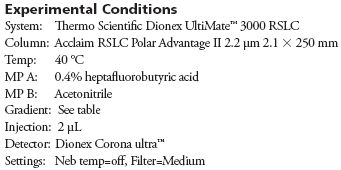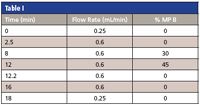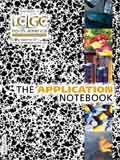UHPLC Analysis of Underivatized Amino Acids
The quantification of derivatized amino acids by (U)HPLC with UV detection is one of the most widely used methods to date. Unfortunately, separation and detection of underivatized amino acids is difficult, as many of them are similar in structure, and few possess adequate chromophores.
The quantification of derivatized amino acids by (U)HPLC with UV detection is one of the most widely used methods to date. Unfortunately, separation and detection of underivatized amino acids is difficult, as many of them are similar in structure, and few possess adequate chromophores. The use of derivatization agents, either pre- or post-column, may overcome some of these issues, but can add time and complexity to the method. Presented here is a simple UHPLC gradient method using the new Thermo Scientific Acclaim™ RSLC PAII 2.1 × 250 mm column with Thermo Scientific Dionex Corona™ Charged Aerosol Detection (CAD) for the measurement of 22 underivatized amino acids. Retention of hydrophilic amino acids was achieved by the addition of a volatile ion-pairing agent heptafluorobutyric acid (HFBA) to the mobile phase. All analytes were resolved in <10 min with a limit of detection of low nanograms on column, making this approach ideal for the analysis of amino acids standards and starting materials in quality control. This approach has also been expanded to analysis of tryptic digests and hydrolysate of soya bean (1,2).

Figure 1: Column: Acclaim RSLC Polar Advantage II 2.2 µm 2.1 à 250 mm; Peaks: 1. Sodium, 2. Glycine/Threonine, 3. Aspartic Acid, 4. Glutamine, 5. Asparagine, 6. Alanine, 7. Glutamic Acid, 8. Citruline, 9. Proline, 10. Ornithine, 11. Lysine, 12. Histidine, 13. Valine, 14. Methionine, 15. DOPA, 16. Arginine, 17. Tyrosine, 18. Isoleucine, 19. Leucine, 20. Norleucine, 21. Phenylalanine, 22. Tryptophan.

As seen in Figure 1, the 22 amino acids were all resolved, with the exception of glycine and threonine, which co-eluted in peak number 2. The ability to resolve and quantify proline and lysine, peaks 9 and 11, respectively, is an improvement over derivatization approaches that require a two-step derivatization protocol with OPA (for lysine and all primary amino acids) and with FMOC (for proline). The limits of detection were in the low nanogram on column level for the all amino acids. Although this is not as sensitive as the derivatization techniques, such as OPA with fluorescence or post-column with ninhydrin, it is a vast improvement over low wavelength UV, which typically only achieves high nanogram to microgram limits of detection. This fast UHPLC method provides a simple alternative to the more time consuming or less sensitive amino acid methods typically used to measure analytes in a simple matrix.

Table I
References
(1) Analysis of Tryptic Digest of a Protein using UV and Charged Aerosol Detection. http://dlibrary.dionex.com/Public/View.aspx?ApplicationID=259.
(2) Webcast: New Approaches for Analysis of Amino Acids by Liquid Chromatography, July 2011. http://www.dionex.com/en-us/events/webinars/lp-110804.html.
Dionex, now part of Thermo Fisher Scientific
1228 Titan Way, P.O. Box 3603, Sunnyvale, CA 94088
tel. (408) 737-0700, fax (408) 730-9403

SEC-MALS of Antibody Therapeutics—A Robust Method for In-Depth Sample Characterization
June 1st 2022Monoclonal antibodies (mAbs) are effective therapeutics for cancers, auto-immune diseases, viral infections, and other diseases. Recent developments in antibody therapeutics aim to add more specific binding regions (bi- and multi-specificity) to increase their effectiveness and/or to downsize the molecule to the specific binding regions (for example, scFv or Fab fragment) to achieve better penetration of the tissue. As the molecule gets more complex, the possible high and low molecular weight (H/LMW) impurities become more complex, too. In order to accurately analyze the various species, more advanced detection than ultraviolet (UV) is required to characterize a mAb sample.

.png&w=3840&q=75)

.png&w=3840&q=75)



.png&w=3840&q=75)



.png&w=3840&q=75)














